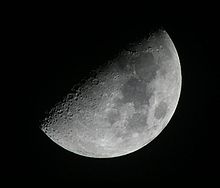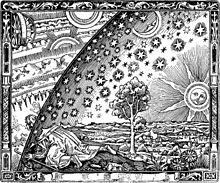- Night sky
-
For other uses, see Night sky (disambiguation).
 The Moon is the most common major object viewed in the night sky.
The Moon is the most common major object viewed in the night sky.
The term night sky refers to the sky as seen at night. The term is usually associated with astronomy, with reference to views of celestial bodies such as stars, the Moon, and planets that become visible on a clear night after the Sun has set. Natural light sources in a night sky include moonlight, starlight, and airglow, depending on location and timing. Weather phenomenon such nighttime thunderstorms can dominate the sky, and transient events such as a great comet.
The night sky and studies of it have a historical place in both ancient and modern cultures. In the past, for instance, farmers have used the state of the night sky as a calendar to determine when to plant crops. Many cultures have drawn constellations between stars in the sky, using them in association with legends and mythology about their deities.
The anciently developed belief of astrology is generally based on the belief that relationships between heavenly bodies influence or convey information about events on Earth. The scientific study of the night sky and bodies observed within it, meanwhile, takes place in the science of astronomy.
The visibility of celestial objects in the night sky is affected by light pollution. The presence of the Moon in the night sky has historically hindered astronomical observation by increasing the amount of ambient lighting. With the advent of artificial light sources, however, light pollution has been a growing problem for viewing the night sky. Special filters and modifications to light fixtures can help to alleviate this problem, but for the best seeing both professional and amateur optical astronomers seek viewing sites located far from major urban areas.
Contents
Visual presentation
Stars are, depending on how dark the sky is, hundreds or thousands of white pinpoints of light in an otherwise black sky.[1] To the naked eye, they all appear to be equidistant on a dome above the earth because stars are much too far away for stereopsis to offer any depth cues. Visible stars range in color from blue (hot) to red (cold), but with such small points of faint light, most look white because they stimulate the rod cells without triggering the cone cells. If it is particularly dark and a particularly faint celestial object is of interest, averted vision may be helpful.
The stars of the night sky cannot be counted unaided because they are so numerous and there is no way to track which have been counted and which have not. Further complicating the count, fainter stars may appear and disappear depending on exactly where the observer is looking. The result is an impression of an extraordinarily vast star field.
Because stargazing is best done from a dark place away from city lights, dark adaptation is important to achieve and maintain. It takes several minutes for eyes to adjust to the darkness necessary for seeing the most stars, and surroundings on the ground are hard to discern. A red flashlight (torch) can be used to illuminate star charts, telescope parts, and the like without undoing the dark adaptation. (See Purkinje effect).
Constellations
There are no markings on the night sky, though there exist many sky maps to aid stargazers in identifying constellations and other celestial objects. Constellations are prominent because their stars tend to be brighter than other nearby stars in the sky. Different cultures have created different groupings of constellations based on differing interpretations of the more-or-less random patterns of dots in the sky. Constellations were identified without regard to distance to each star, but instead as if they were all dots on a dome.
Orion is among the most prominent and recognizable constellations.[2] The Big Dipper (which has a wide variety of other names) is helpful for navigation in the northern hemisphere because it points to Polaris, the north star.
The pole stars are special because they are approximately in line with the Earth's axis of rotation so they appear to stay in one place while the other stars rotate around them through the course of a night (or a year).
Planets
Planets, named for the Greek word for "wanderer," process through the star field a little each day. Planets, to the naked eye, look like additional points of light in the sky. The disc is not apparent without binoculars or a telescope. Venus is the most prominent planet, often called the "morning star" or "evening star" because it is brighter than the stars and visible near sunrise or sunset depending on its location in its orbit. Mercury, Mars, Jupiter and Saturn are also visible to the naked eye.
The Moon
Earth's Moon is a gray disc in the sky with cratering visible to the naked eye. It spans, depending on its exact location, 29-43 arcminutes - which is about the size of a thumbnail at arm's length, and is readily identified. Over 28 days, the moon goes through a full cycle of lunar phases. People can generally identify phases within a few days by looking at the moon. Unlike stars and planets, the light reflected from the moon is bright enough to be seen during the day.
Some of the most spectacular moons come during the full moon phase near sunset or sunrise. The moon on the horizon benefits from the moon illusion which makes it appear larger. The light reflected from the moon traveling through the atmosphere also colors the moon orange and/or red.
Comets
Comets come to the night sky only rarely. Comets are illuminated by the sun, and their tails extend away from the sun. A comet with visible tail is quite unusual - a great comet appears about once a decade. They tend to be visible only shortly before sunrise or after sunset because those are the times they are close enough to the sun to show a tail.
Clouds
Clouds obscure the view of other objects in the sky, though varying thicknesses of cloudcover have differing effects. A very thin cirrus cloud in front of the moon might produce a rainbow-colored ring around the moon. Stars and planets are too small or dim to take on this effect, and are instead only dimmed (often to the point of invisibility). Thicker cloudcover obscures celestial objects entirely, making the sky black or reflecting city lights back down. Clouds are often close enough to afford some depth perception, though they are hard to see without moonlight or light pollution.
Other objects
The Milky Way can be seen as a very large streak or arc across the night sky if the visibility conditions are good enough. This panoramic photo was taken at Death Valley.
On clear deep nights in unpolluted areas, when the moon is thin or below the horizon, a band of what looks like white dust, the Milky Way, can be seen.
Shortly after sunset and before sunrise, artificial satellites often look like stars - similar in brightness and size, but different because they move relatively quickly; those that fly in near-earth orbit cross the sky in a couple of minutes. Some satellites (including space junk) appear to blink or have a periodic fluctuation in brightness because they are rotating.
Meteors (commonly known as shooting stars) streak across the sky very infrequently. During a meteor shower, they may average one a minute not at regular intervals, but otherwise their appearance is a random surprise. The occasional meteor will make a bright, fleeting streak across the sky, and they can be very bright in comparison to the night sky.
Aircraft are also visible at night, distinguishable at a distance from other objects because their lights blink.
References
- ^ Hawley. "Number of Stars in the Sky". NEWTON Ask A Scientist. US Department of Energy. http://www.newton.dep.anl.gov/askasci/ast99/ast99238.htm. Retrieved October 23, 2010.
- ^ Dolan, Chris. "Orion". http://www.astro.wisc.edu/~dolan/constellations/constellations/Orion.html. Retrieved 2007-10-05.
See also
- Amateur astronomy
- Asterism (astronomy)
- Astrology
- Astronomical object
- Constellation
- Earth's shadow
- Planetarium
External links
- A virtual panorama of winter night. Pokljuka, Slovenia. Burger.si. Accessed 28 February 2011.
Categories:
Wikimedia Foundation. 2010.


